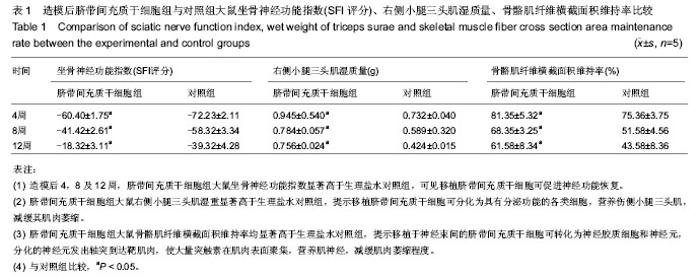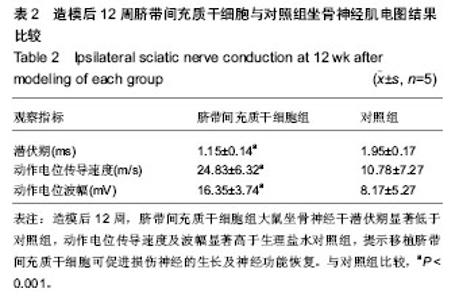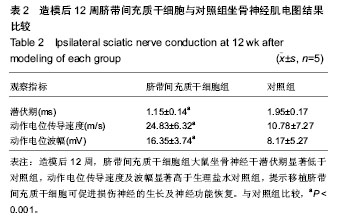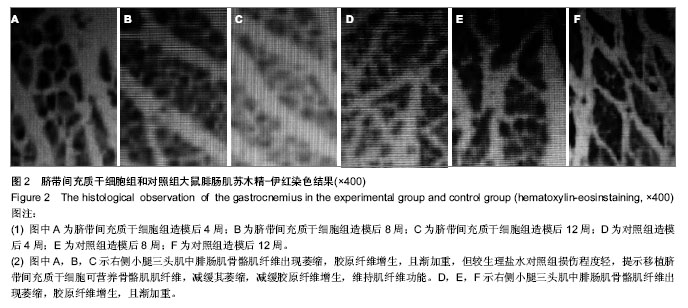| [1] 杨渐,俞昌喜,周围神经损伤的药物治疗进展[J].中国实用神经疾病杂志,2010,13(11):91-93.[2] Kang JR,Zamorano DP, Gupta R.Limb salvage with major nerve injury: current management and future directions.J Am Acad Orthop Surg. 2011;19 Suppl 1:S28-34. [3] 陈玉清,李琳,王龙安,等.异基因外周血造血干细胞移植治疗白血病[J].中国组织工程研究,2012,16(19):3535-3539. [4] Kuh SU, Cho YE, Yoon DH, et al.Functional recovery after human umbilical cord blood cells transplantation with brain-derived neutrophic factor into the spinal cord injured rat.Acta Neurochirurgica. 2005;147:985-992.[5] 李华,文峰,漆仲春,等.人脐带间充质干细胞与肝细胞共培养可分化为肝样细胞[J].中国组织工程研究,2013,17(32):5772- 5777.[6] Varejão AS, Meek MF, Ferreira AJ, et al.Functional evaluation of peripheral nerve regeneration in the rat:walking track analysis. J Neurosci Methods. 2001;108(1):1-9.[7] 张彩顺,吕刚,张基仁,等.无细胞神经移植物复合骨髓间充质干细胞修复大鼠坐骨神经缺损[J].中国组织工程研究与临床康复, 2009,13(28):5429-5432.[8] 沈云东,徐建光,徐文东,等.神经干细胞移植延缓失神经肌肉萎缩的实验研究[J].中国修复重建外科杂志, 2008, 22(9):1051-1055.[9] Borisov AB, Huang SK, Carlson BM. Remodeling of the vascular bed and progressive loss of capillaries in denervated skeletal muscle. Anat Rec. 2000;258(3): 292-304.[10] Shi ED, Wang BC, Sun QS. Nerve growth factor and injured peripheral nerve regeneration. Neural Negen Res. 2008;3(11): 1273-1276 .[11] Kang JR,Zamorano DP, Gupta R.Limb salvage with major nerve injury: current management and future directions. J Am Acad Orthop Surg. 2011;19 Suppl 1:S28-34.[12] 蔡文琴,阮怀珍,黎海蒂.医用神经生物学基础[M].重庆:西南师范大学出版社, 2001: 46.[13] Burnett MG, Zager EL. Pathophysiology of peripheral nerve injury:a brief review. Neurosurg Focus. 2004;16(5):E1.[14] Ruan WD, Xue Y, Li NH, et al. Synaptic development in the injured spinal cord cavity following co-transplantation of fetal spinal cord cells and autologous activated Schwann cells. Neural Regen Res. 2010;5(19): 1445-1450.[15] Wang HS,Hung SC,Peng ST,et al. Mesenchymal stem cells in the Wharton's jelly of the human umbilical cord. Stem Cells. 2004;22(7):1330-1337.[16] Xu L, Zhou S, Feng GY,et al . Neural stem cells enhance nerve regeneration after sciatic nerve injury in rats. Mol Neurobiol. 2012;46(2):265-274.[17] Yang XF, Xu YF, Lü NW, et al. Umbilical cord mesenchymal stem cell transplantation for the treatment of Duchenne muscular dystrophy. Neural Regen Res. 2011;6(10): 785-789.[18] 朱玉海,冯世庆.人脐带间充质干细胞和大鼠激活态雪旺细胞联合培养的实验研究[J].天津医药,2012, 40(3):251-253.[19] Coutts M, Keirstead HS. Stem cells for the treatment of spinal cord injury. Exp Neurol. 2008;209(2):368-377.[20] Koda M, Nishio Y, Kamada T,et al.Granulocyte colony- stimulating factor (G-CSF) mobilizes bone marrow-derived cells into injured spinal cord andpromotes functional recovery after compression-induced spinal cord injury in mice.Brain Res. 2007;1149:223-231.[21] Chang HM, Shyu MK, Tseng GF,et al, Neuregulin facilitates nerve regeneration by speeding Schwann cell migration via ErbB2/3-dependent FAK pathway. PLoS One. 2013;8(1): e53444.[22] Zhao C, Veltri K, Li S, et al. NGF, BDNF, NT-3, and GDNF mRNA expression in rat skeletal muscle following denervation and sensory protection. J Neurotrauma. 2004;21(10): 1468-1478.[23] Simon M, Porter R, Brown R, et al. Effect of NT-4 and BDNF delivery to damaged sciatic nerves on phenoltypic recovery of fast and slow muscles fi bres. Eur J Neurosci. 2003;18(9): 2460-2466.[24] Burns AS, Boyce VS, Tessler A, et al. Fibrillation potentials following spinal cord injury: improvement with neurotrophins and exercise. Muscle Nerve. 2007; 35(5): 607-613.[25] Chen X, Mao Z, Liu S, et al. Dediff erentiation of adult human myoblasts induced by ciliary neurotrophic factor in vitro. Mol Biol Cell. 2005;16(7): 3140-3151.[26] Day CS, Buranapanitkit B, Riano FA, et al. Insulin growth factor-1 decreases muscle atrophy following denervation. Microsurgery. 2002;22(4): 144-151.[27] Adi S, Bin-Abbas B, Wu NY, et al. Early stimulation and late inhibition of extracellular signal-regulated kinase 1/2 phosphorylation by IGF-I: a potential mechanism mediating the switch in IGF-I action on skeletal muscle cell diff erentiation. Endocrinology. 2002;143(2): 511-516.[28] 朱家恺,罗永湘,陈统一.现代周围神经外科学[M]. 上海:上海科学技术出版社, 2007:295.[29] 沈宁江,朱家恺.坐骨神经功能指数在神经功能评价中的应用[J]. 中华显微外科杂志, 1993,16(4):284. [30] Sunderland S. Factors influencing the development and severity of the changes in denervated muscle Nerve injury and their repair: a critical appraisal. London: Churchill Livingstone, 1991: 241-263.[31] 沈云东,徐建光,徐文东,等.绿色荧光蛋白转基因大鼠神经干细胞体外分化及体内移植的实验研究[J].中华手外科杂志, 2007, 23(4):196-199.[32] 沈云东,徐建光,徐文东,等.神经干细胞移植延缓失神经肌肉萎缩的实验研究[J].中国修复重建外科杂志, 2008,22(9):1051-1055.[33] 朱家恺,罗永湘,陈统一.现代周围神经外科学[M].上海:上海科学技术出版社, 2007:296. [34] Amariglio N,Hirshberg A,Scheithauer BW,et al.Donor-derived brain tumor following neural stem cell transplantation in an ataxia telangiectasia patient. PLoS Med. 2009; 6(2): e1000029. |





